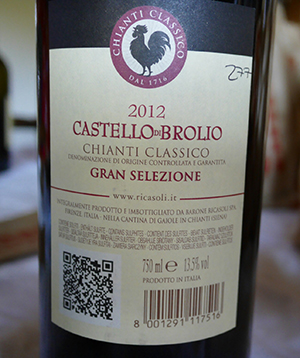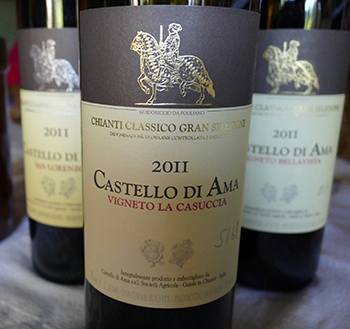Tasting Report: Chianti Classico Gran Selezione Versus Riserva

Having blind-tasted what are surely Chianti Classico’s best 80-odd wines, I must admit that I find it hard to note great differences between those labeled Gran Selezione or Riserva. But my wines in the tasting were Gran Selezione.
To be sure, such wines as Castello di Ama's single-vineyard Chianti Classicos (especially Vigneto La Casuccia Gran Selezione and San Lorenzo Gran Selezione) or Barone Ricasoli's Castello di Brolio Gran Selezione show all the structure and beauty one might even expect from a Brunello di Montalcino. It’s also true that the designation must represent the latest bandwagon a producer from the area should be looking to climb aboard in the market.
Yet it remains difficult to believe that these recent 95-, 96-, even 97-point wines are outstanding quality because they are Gran Selezione, rather than already being outstanding quality and now happening to be called Gran Selezione. I have already written extensively on this, and we have numerous videos on the subject. I was certainly not in favor of the policy that allowed Chianti Classico producers to designate a wine as Gran Selezione retroactively. Perhaps the Consorzio should have only permitted bottles with grapes harvested in 2013 – when the new legislation took effect – to be labeled as such.

Anyways, I think it's a step in the right direction, and Gran Selezione is gaining recognition internationally from North America to Asia. At the very least, consumers are beginning to differentiate with Chianti Classico, and indeed Chianti as whole. And they are understanding that Gran Selezione can represent the best of Tuscany.
The next move for Chianti Classico is of course to recognize specific villages or comunes within the Classico area as well as single vineyards just as is done in the world’s greatest wine areas from Barolo to Burgundy. Naturally, it will take time. But Chianti Classico deserves this distinction as one of the world's unique winemaking areas.
Just as a reminder, in contrast to Riservas, Gran Selezione:
- Must come from grapes exclusively under the management of the winery in question instead of source in the appellations
- Must undergo at least 30 months of aging in barrel instead of 24
- Must meet certain chemical requirements (such as an ABV of 13% instead of 12%)
As far as vintages are concerned, I think that 2011 is an outstanding year for Chianti Classico, during which rich and ripe wines were made that remain fresh and lively. It was a hotter and drier growing season compared to 2010, and Chianti Classico may well have made better wines than Brunello di Montalcino in 2011. Even so, I still think that the aromatic quality and structure of 2010 is superior for Chianti Classico and, of course, Brunello di Montalcino, not to mention most other appellations in Tuscany. The 2012 is not as good quality as 2011 or 2010 but produced many outstanding Chianti Classiocs, regardless if they are Gran Selezione or Riserva.
Photo 1: Castello di Barolio Chianti Classico Gran Selezione 2012; Photo 2: Castello di Ama Vigneto la Casuccia Chianti Classico 2011; Fontodi Chianti Classico Gran Selezione 2012